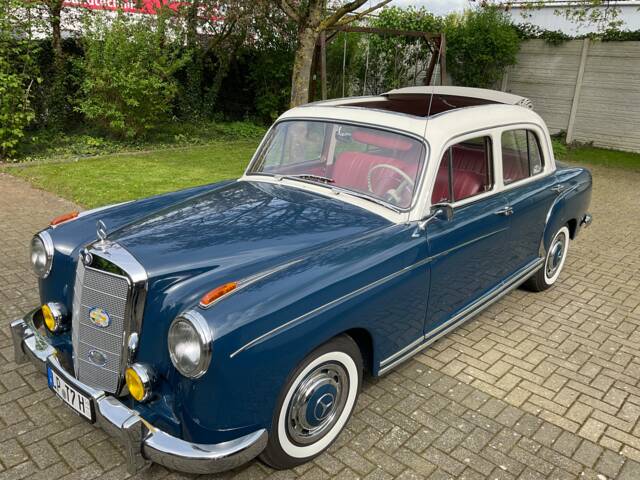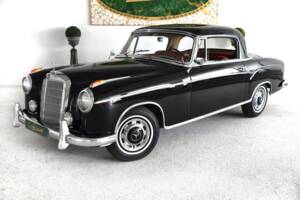- Car
- Mercedes-Benz
- Mercedes-Benz Ponton (44 offers)
Mercedes-Benz Ponton For Sale
The Mercedes-Benz Ponton classic, manufactured between 1953 and 1962, is one of the defining models of the post-war period and marked a turning point in vehicle development for Mercedes-Benz. The name "Ponton" refers to the body style, the first to be designed without separate fenders—a forward-thinking design that led the way into modernity. In the classic car scene, Mercedes-Benz Ponton is revered as a timeless classic, known for its robust engineering and comfortable driving experience. Discover more about its history, models, and essential buying criteria here.
Search results
1957 | Mercedes-Benz 220 S
Mercedes-Benz Ponton 220-S, W 180, Faltdach, Zust.1-
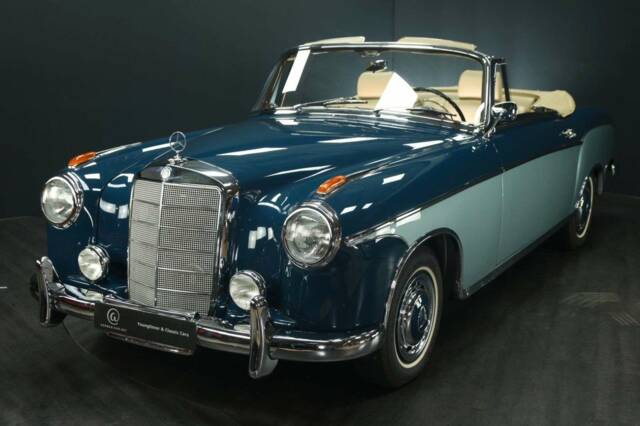
1957 | Mercedes-Benz 220 S Cabriolet
Mercedes-Benz 220
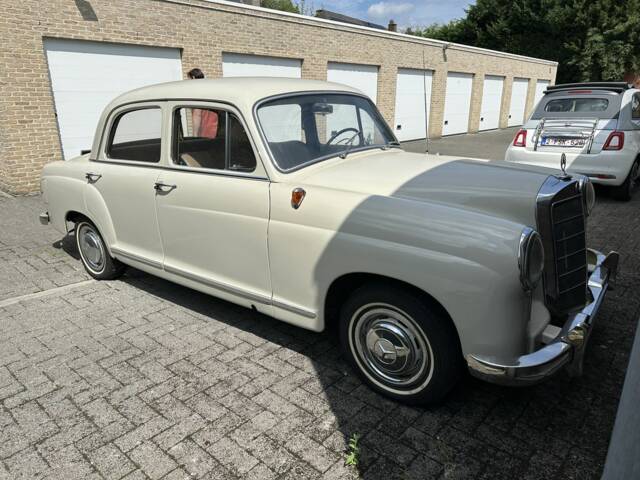
1959 | Mercedes-Benz 190
Mercedes-Benz 190 | 1959 | Route 66 Auctions - For sale by auction. Estimate 11500 EUR

1960 | Mercedes-Benz 220 SE
Mercedes-Benz 220 SE Coupe | 1960 | Route 66 Auctions - For sale by auction. Estimate 32500 EUR

1958 | Mercedes-Benz 220 S Cabriolet
Mercedes-Benz 220S cabriolet | 1958 | Route 66 Auctions - For sale by auction. Estimate 77500 EUR
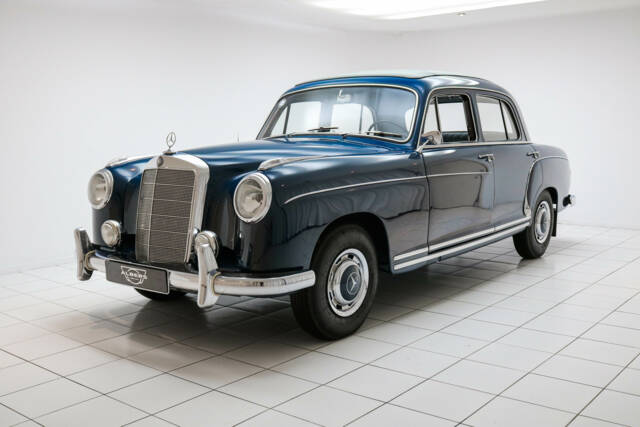
1958 | Mercedes-Benz 220 SE
Restored – Sunroof – Excellent Condition – Documented History
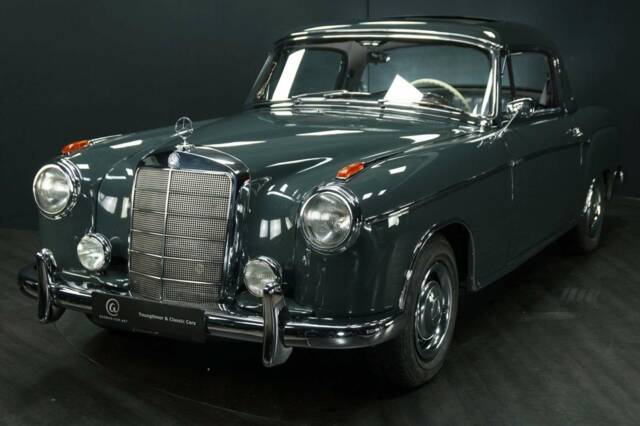
1960 | Mercedes-Benz 220 SE
Mercedes-Benz 220

1957 | Mercedes-Benz 190
MERCEDES 190 PONTON (Petrol)

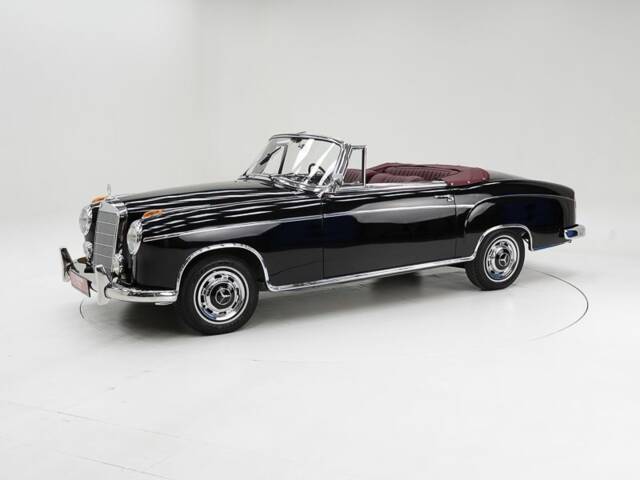
1959 | Mercedes-Benz 220 S Cabriolet
1959 Mercedes-Benz 220 S Ponton Cabriolet '59

1957 | Mercedes-Benz 220 S Cabriolet
Scheunenfund

1960 | Mercedes-Benz 180 b
Top Originalzustand, nur 3 Vorbesitzer! MFK 03.2024!
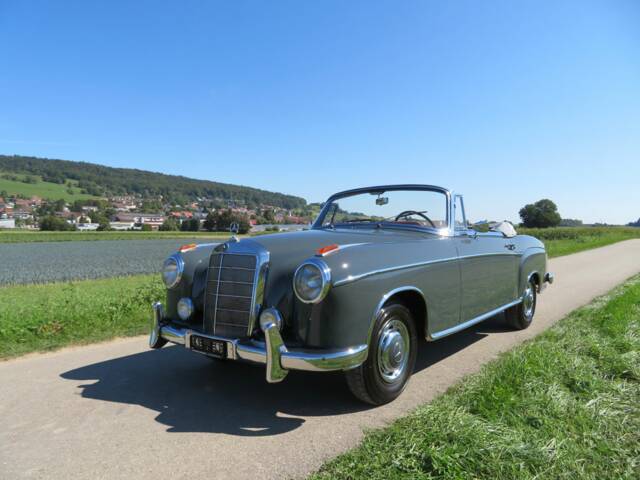
1957 | Mercedes-Benz 220 S Cabriolet
TOP-Zustand - MFK 2022 Veteran!
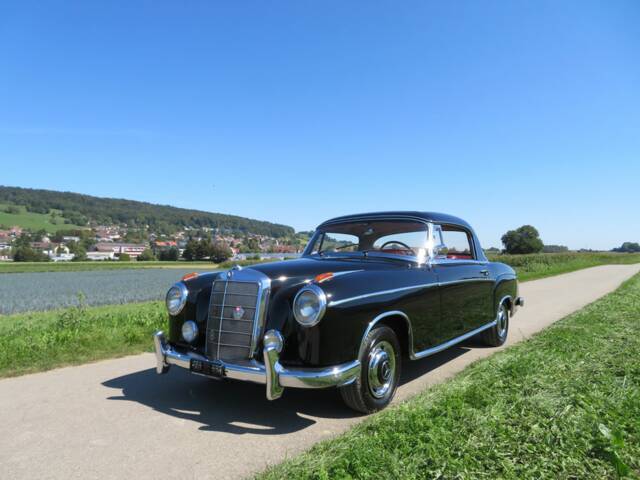
1958 | Mercedes-Benz 220 S
CH-Auslieferung - 3. Hand - MFK 2022 Veteran!

1960 | Mercedes-Benz 220 SE
Mercedes-Benz 220 SE Ponton Coupé (W128)
History of the Mercedes-Benz Ponton Classic
The Mercedes-Benz Ponton paved the way for a new era at Mercedes-Benz, both technically and stylistically. In 1953, the W 120/W 121 series was introduced with the 180 model, the first Mercedes to feature a unibody construction. This approach offered many advantages, such as improved driving stability and increased safety. The Ponton also set new technical standards with its independent suspension on both the front and rear axles, providing a remarkably comfortable ride, especially for its time.
The Ponton series underwent continuous development over the years. The most well-known variants are models 180, 190, 220, and 219, each with diverse engine options and comfort features. Particularly popular were the six-cylinder models 220 and 219, which offered both performance and luxury. The Ponton era concluded in 1962 when it was succeeded by the "fintail" series.
Popular Mercedes-Benz Ponton Classic Models
- Mercedes-Benz 180 (W 120, 1953–1962): The entry-level model of the Ponton series equipped with a four-cylinder engine, the 180 was aimed at the mass market and was known for its durability. Its understated elegance and reliability made it a bestseller.
- Mercedes-Benz 180 D (W 120, 1954–1959): The diesel variant of the base model, featuring a 1.8-liter four-cylinder diesel engine with 43 HP. The 180 D was known for its reliability and efficiency, popular among taxi drivers and frequent travelers.
- Mercedes-Benz 190 (W 121, 1956–1961): An evolution of the 180, the 190 came with a more powerful 1.9-liter engine delivering 75 HP and offered more comfort. It was also available as the "190D" with a diesel engine and was among the first vehicles to popularize diesel power in passenger cars.
- Mercedes-Benz 220 (W 180, 1954–1959): The luxury version of the Ponton series, featuring a six-cylinder engine offering 85 to 100 HP. This model was a favorite among the elite and stood out for its smooth power delivery and premium features.
- Mercedes-Benz 220 SE (W 128, 1958–1960): The flagship model of the Ponton series, equipped with a 2.2-liter six-cylinder engine with fuel injection. With 115 HP, the 220SE boasted the highest performance of the Ponton range and came with a very luxurious interior. Available as a sedan, coupe, and convertible, it remains a coveted collector's item today.
- Mercedes-Benz 219 (W 105, 1956–1959): The 219 blended the chassis of the 180 with the six-cylinder engine of the 220, serving as a bridge between the four-cylinder and larger six-cylinder models. It balanced power with elegance and is now a sought-after classic. Compared to the 220, it featured a simpler interior and less chrome detailing.
Notable Features of the Mercedes-Benz Ponton Classic
The Mercedes-Benz Ponton classic set the standard in comfort and safety. Its unibody construction, unlike earlier models that were mounted on a frame, offered significantly better driving dynamics. Its design was a breakthrough: it was Mercedes-Benz's first model with a rounded shape without protruding fenders, giving it a sleek, modern look. The independent suspension on both axles provided a smooth driving experience, notable for its era.
Key Buying Criteria for Mercedes-Benz Ponton Classics
- Documentation and History: A comprehensive history is invaluable when looking into a Mercedes-Benz Ponton classic. Ensure that maintenance and restoration work are well documented to verify the authenticity and condition of the vehicle.
- Spare Parts Availability: Spare parts for the Mercedes-Benz Ponton classic are still widely available, but body parts can be expensive. Check whether the vehicle is equipped with original parts or restored components.
- Rare Models: Certain variants like the 220 S or 190 D are particularly desirable. Their rarity can significantly impact the price, especially if the vehicle is in good original condition.
- Interior Condition: The interior of a Mercedes-Benz Ponton classic often features premium materials like leather and real wood. Authentic or well-restored interiors are a significant plus and considerably increase the vehicle's value.
Specifications of the Mercedes-Benz Ponton Classic
Here's an overview of the key specifications and features of the most popular Mercedes-Benz Ponton classics:
| Series | Model | Chassis | Production Years | Body Styles | Engine | Power |
|---|---|---|---|---|---|---|
| Mercedes-Benz Ponton | 180 | W 120 | 1953-1962 | Sedan | 1.8-liter inline 4-cylinder | 52-65 HP |
| Mercedes-Benz Ponton | 180 D | W 120 | 1954-1959 | Sedan | 1.8-liter inline 4-cylinder Diesel | 40-43 HP |
| Mercedes-Benz Ponton | 190 | W 121 | 1956-1961 | Sedan | 1.9-liter inline 4-cylinder | 75 HP |
| Mercedes-Benz Ponton | 220 | W 180 | 1954-1959 | Sedan, Convertible, Coupe | 2.2-liter inline 6-cylinder | 85-100 HP |
| Mercedes-Benz Ponton | 220 S | W 180 | 1956-1959 | Sedan, Convertible, Coupe | 2.2-liter inline 6-cylinder | 100-106 HP |
| Mercedes-Benz Ponton | 220 SE | W 128 | 1958-1960 | Sedan, Convertible, Coupe | 2.2-liter inline 6-cylinder (injection) | 115 HP |
| Mercedes-Benz Ponton | 219 | W 105 | 1956-1959 | Sedan | 2.2-liter inline 6-cylinder | 85 HP |
Restoration of Mercedes-Benz Ponton Classics
Restoring a Mercedes-Benz Ponton classic requires special care due to the age of these models. Maintaining the original condition is particularly challenging as many vehicles have been modified or improperly repaired over the decades. Successful restoration depends on using historically accurate spare parts, which contribute not only to the appearance but also to the vehicle's long-term value retention.
The bodywork also plays a crucial role in restoration. Rust is a common issue in Ponton models, especially in structural areas such as sills and the underbody. Professional restoration should focus not only on the vehicle's outward appearance but also on its structural integrity. For collectors and enthusiasts aiming to restore the Ponton to its original splendor, collaborating with specialists familiar with the Ponton series is often worthwhile. Such meticulous restoration significantly enhances the vehicle's market value.
Conclusion
The Mercedes-Benz Ponton classic remains a revered model for its technical innovation, elegant design, and reliable engineering. Whether in sedan form or as a luxurious convertible, the Ponton delivers a unique driving experience rooted in the golden age of automotive craftsmanship. At Classic Trader, you'll find a carefully curated selection of Mercedes-Benz Ponton classics. Explore this automotive icon and take a piece of history for a drive.
FAQs about Mercedes-Benz Ponton Classics
Why is the Mercedes-Benz Ponton classic car so popular?
The Mercedes-Benz Ponton is considered one of the most iconic classic cars of its era. Its popularity stems from its durable engines, innovative unibody construction, and timeless design, making it a sought-after classic. Known for longevity and remarkable mileage, it appeals to both collectors and drivers alike.
How can I find spare parts for the Mercedes-Benz Ponton classic car?
Spare parts for the Mercedes-Benz Ponton classic car are still readily available. Specialized dealers and the Mercedes-Benz Classic Center offer a wide range of parts. Additionally, numerous classic car clubs can assist in locating rare components.
What should I consider when buying a Mercedes-Benz Ponton classic car?
Pay close attention to the condition of the bodywork, especially with regard to rust. Having a complete history of the vehicle, including any restorations, greatly assists in making an informed purchase decision.
